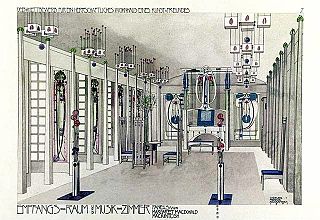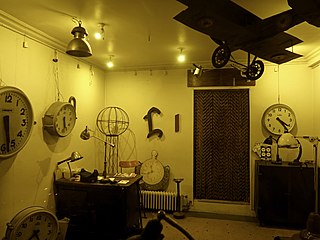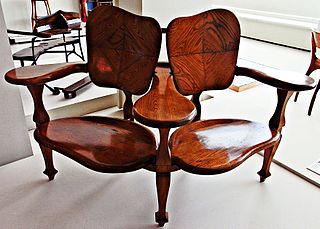Related Research Articles

Interior design is the art and science of enhancing the interior of a building to achieve a healthier and more aesthetically pleasing environment for the people using the space. With a keen eye for detail and a creative flair, an interior designer is someone who plans, researches, coordinates, and manages such enhancement projects. Interior design is a multifaceted profession that includes conceptual development, space planning, site inspections, programming, research, communicating with the stakeholders of a project, construction management, and execution of the design.

In Western architecture, a living room, also called a lounge room, lounge, sitting room, or drawing room, is a room for relaxing and socializing in a residential house or apartment. Such a room is sometimes called a front room when it is near the main entrance at the front of the house. In large, formal homes, a sitting room is often a small private living area adjacent to a bedroom, such as the Queens' Sitting Room and the Lincoln Sitting Room of the White House.

Interior architecture is the design of a building or shelter from inside out, or the design of a new interior for a type of home that can be fixed. It can refer to the initial design and plan used for a building's interior, to that interior's later redesign made to accommodate a changed purpose, or to the significant revision of an original design for the adaptive reuse of the shell of the building concerned. The latter is often part of sustainable architecture practices, whereby resources are conserved by "recycling" a structure through adaptive redesign.

Mid-century modern (MCM) is a movement in interior design, product design, graphic design, architecture and urban development that was present in all the world, but more popular in North America, Brazil and Europe from roughly 1945 to 1970 during the United States's post-World War II period.

Florence Marguerite Knoll Bassett was an American architect, interior designer, furniture designer, and entrepreneur who has been credited with revolutionizing office design and bringing modernist design to office interiors. Knoll and her husband, Hans Knoll, built Knoll Associates into a leader in the fields of furniture and interior design. She worked to professionalize the field of interior design, fighting against gendered stereotypes of the decorator. She is known for her open office designs, populated with modernist furniture and organized rationally for the needs of office workers. Her modernist aesthetic was known for clean lines and clear geometries that were humanized with textures, organic shapes, and colour.

Industrial style or industrial chic refers to an aesthetic trend in interior design that takes cues from old factories and industrial spaces that in recent years have been converted to lofts and other living spaces. Components of industrial style include weathered wood, building systems, exposed brick, industrial lighting fixtures and concrete.

Kelly Wearstler is an American designer. She founded her own design firm Kelly Wearstler Interior Design in the mid-1990s, serving mainly the hotel industry, and now designs across high-end residential, commercial, retail and hospitality spaces. Her designs for the Viceroy hotel chain in the early 2000s have been noted for their influence on the design industry. She has designed properties for clients such as Gwen Stefani, Cameron Diaz and Stacey Snider, and served as a judge on all episodes of Bravo's Top Design reality contest in 2007 and 2008.
Michael Sean Smith is an American interior designer based in Los Angeles. Smith was appointed by President Barack Obama to the Committee for the Preservation of the White House from 2008-2016 and is responsible for the 2010 makeover of the Oval Office.

Home accessories are decorative and functional items used to enhance the aesthetic appeal and comfort of living spaces. These items are typically easy to replace, move, and rearrange, allowing for flexibility in interior design.
An interior design magazine is a publication that focuses primarily on interior design in a hard copy periodical format or on the Internet.
Frances Adler Elkins, was one of the twentieth century's most prominent interior designers. According to one magazine editor, she was "the first great California decorator". According to The New York Times, Elkins "pioneered vibrant interiors, in which solid historical references met effervescent modernist fantasy." She was the sister of the architect David Adler.
James Huniford or Ford Huniford is an American designer. After founding his own design firm Huniford Design Studio, his ensuing work within the residential design built his reputation in New York with work appearing in Architectural Digest, W Magazine, Vogue, the New York Times, and Elle Decor. He was chosen by New York Spaces as a 'Top 50' designer of 2015 and was among Elle Decor's 2016 and 2011 'A-List's stating his work as "decorating at its most muscular and glamorous".

The Confidant from Casa Batlló, also known as the Double Sofa or Banc de dues places , is a furniture piece designed by Antoni Gaudí. Originally designed for the dining room of Casa Batlló on Barcelona's Passeig de Gràcia, the chair is currently exhibited in the Modern Art collection of the Museu Nacional d'Art de Catalunya and at Gaudí House Museum in Barcelona. Replicas are displayed at the Gaudí-designed Casa Batlló and Casa Milà.

Parametric design is a design method in which features, such as building elements and engineering components, are shaped based on algorithmic processes rather than direct manipulation. In this approach, parameters and rules establish the relationship between design intent and design response. The term parametric refers to the input parameters that are fed into the algorithms.
Thomas O'Brien is an American interior and home furnishings designer. His design firm, Aero Studios, and home store, Aero Ltd., are both based in New York City's SoHo neighborhood.
Marmol Radziner is a design-build practice based in Los Angeles that was founded in 1989 by American architects Leo Marmol and Ron Radziner. The firm specializes in residential, commercial, hospitality, cultural, and community projects, and offers various design services, including architectural design, construction, landscape design, interior design, furniture design, jewelry design, and modern architecture restoration.

India Mahdavi is an Iranian-French architect and designer. Over 20 years since launching her own studio, Mahdavi has built a name for herself—working on large hospitality projects, luxury collaborations, and even launching her own furniture line. Often referred to as the “reigning queen of color,” Mahdavi is most known for her whimsical spaces and forms infused with playful palettes. Projects include the Hotel du Cloitre in Arles, Coburg Bar at London's Connaught Hotel, Monte Carlo Beach in Monaco, Rivington Hotel in Manhattan and the Townhouse Hotel in Miami.

Ike Kligerman Barkley was an American architectural firm established in 1989 and dissolved in 2022. The firm had offices in New York City and the San Francisco Bay Area. The practice was led by partners and founders John Ike and Thomas A. Kligerman, and Joel Barkley, who joined as a partner in 1999. The firm designed buildings across the United States and elsewhere, and is most known for residences characterized by an eclectic approach to historical precedent, style, materials and client tastes than for a single aesthetic. Architect, educator and architectural historian Robert A. M. Stern described the partners as "modern traditionalists" whose work was "wonderfully consistent in quality and also wonderfully inconsistent in style."
African design encompasses many forms of expression and refers to the forms of design from the continent of Africa and the African diaspora including urban design, architectural design, interior design, product design, art, and fashion design. Africa's many diverse countries are sources of vibrant design with African design influences visible in historical and contemporary art and culture around the world. The study of African design is still limited, particularly from the viewpoint of Africans, and the opportunity to expand its current definition by exploring African visual representations and introducing contemporary design applications remains immense.
Neo-Chinese style, New Chinese style, Neo-Chinese fashion is a late-20th century and early 21st-century movement in architecture, creative arts, and fashion that combines traditional Chinese elements with modern culture in China.
References
- ↑ McLaughlin, Katherine (2023-02-28). "Transitional Design: Everything You Need to Know About This Traditional and Modern Style". Architectural Digest. Retrieved 2024-11-23.
- ↑ "HGTV, Transitional Style". Hgtv.com. Retrieved 2011-10-25.
- ↑ "Transitional Style Defined by Lisa Frederick" . Retrieved 2015-01-20.
- ↑ McLaughlin, Katherine (2023-02-28). "Transitional Design: Everything You Need to Know About This Traditional and Modern Style". Architectural Digest. Retrieved 2024-11-23.
- ↑ "Get to Know 23 Living Room Furniture Style Designs". What A Room. 2023-10-18. Retrieved 2024-11-23.
- ↑ Radcliff, Michelle. "Interior Design Love to Know". Interior Design Love to Know. Retrieved 2011-10-25.
- ↑ "Meet me in the Middle". Buzzle.com. 2005-01-13. Archived from the original on December 18, 2010. Retrieved 2011-10-25.
{{cite web}}: CS1 maint: unfit URL (link)